Cumbria ( /ˈkʌmbriə/, locally /ˈkʊmbriə/) is a non-metropolitan county in North West England, United Kingdom. Cumbria came into existence as a county in 1974 after the passage of the Local Government Act 1972. The county consists of six districts, and in 2008 had a total population of just under half a million.
Cumbria, the third largest ceremonial county in England by area, is bounded to the north by the Scottish council area of Dumfries and Galloway, to the west by the Irish Sea, to the south by Lancashire, to the southeast by North Yorkshire, and to the east by County Durham and Northumberland.
A predominantly rural county, Cumbria contains the Lake District and associated Lake District National Park, considered one of the most beautiful areas of England. The area has provided inspiration for generations of British and foreign artists, writers and musicians. Much of the county is mountainous, with the highest point of the county (and of England) being Scafell Pike at 978 metres (3,209 ft). All the mountains in England that are over 900 metres (3,000 ft) above sea level are in Cumbria. Parts of Hadrian's Wall can be found in the northernmost reaches of the county, in and around Carlisle.
History

At the end the period of British history known as Roman Britain (c.410AD) the inhabitants of Cumbria were Old Welsh speaking native "Romano-Britons" probably descended from the Brigantes tribe who had been conquered by the Roman Empire in about 85AD. The Roman civitas of the Carvetii (sometimes considered to be a sub-tribe of the Brigantes) covered almost the same area as what is now Cumbria. Because Cumbria was on the very edge of the Roman province of Britannia the term "Romano-Briton" is probably not a very accurate term for the people of these parts because despite more than three hundred years of Roman military occupation it is unlikely very many of them understood Latin or were particularly enthusiastic about Roman customs. The names "Cumbria" and " Cumberland" are derived from the name these people gave to themselves, and still do in Wales; Cymru (pronounced cum-ree) which originally meant 'compatriots' in Old Welsh. [1] The place names: Cymru, its Latinised version Cambria, Cumbria and Cumberland, all derive their names from this common root. [2]
During the dark ages Cumbria formed the core of the Brythonic kingdom of Rheged. By the end of the 7th Century most of Cumbria had been incorporated into the Anglo-Saxon kingdom of Northumbria, which later became part of England. Large parts of Cumbria were ruled by Scotland at the time of Norman Conquest of England in 1066 and were excluded from the Domesday Book survey of 1086. In 1092 Cumbria was invaded by William Rufus and reincorporated within England and eventually divided into the counties of Cumberland, Westmorland and Lancashire (the exclave of Furness).
The county of Cumbria was created in 1974 from the areas of the former administrative counties of Cumberland and Westmorland, the Cumberland County Borough of Carlisle, along with the North Lonsdale or Furness part of Lancashire, usually referred to as "Lancashire North of the Sands", (including the county borough of Barrow-in-Furness) and, from the West Riding of Yorkshire, the Sedbergh Rural District. The name "Cumbria" has been used for the territory for centuries.
Local papers The Westmorland Gazette and Cumberland and Westmorland Herald continue to use the name of their historic county . However other publications, such as local government promotional material, describe the area as being in "Cumbria", as do the Lake District National Park Authority and most visitors.
| Timeline of events since the formation of Cumbria | ||
|---|---|---|
Below is a list of notable historical events that have occurred in Cumbria post-1974, and therefore excludes the general history of Westmorland, Cumberland and Furness prior to the formation of Cumbria.
|
Geography
Cumbria is the most northwesterly county of England. The northernmost and southernmost points in Cumbria are just west of Deadwater, Northumberland and South Walney respectively, whilst Kirkby Stephen (close to Tan Hill, Yorkshire) and St Bees Head are the most easterly and westerly points of the county. At 978 metres (3,209 ft) Scafell Pike is the highest point in Cumbria and in England, whilst Windermere is the largest lake in Cumbria and also the largest in England. There are however higher points and larger lakes in other countries within the United Kingdom.
Boundaries and divisions
Cumbria is neighboured by the English counties of Northumberland, County Durham, North Yorkshire, Lancashire, and the Scottish council areas of Dumfries and Galloway and Scottish Borders.
The boundaries are along the Irish Sea to Morecambe Bay in the west, and along the Pennines to the east. Cumbria's northern boundary stretches from the Solway Firth from the Solway Plain eastward along the border with Scotland to Northumberland.
It is made up of six districts: Allerdale, Barrow-in-Furness, Carlisle, Copeland, Eden and South Lakeland. For many administrative purposes Cumbria is divided into three areas — East, West and South. East consists of the districts of Carlisle and Eden, West consists of Allerdale and Copeland, and South consists of Lakeland and Barrow.
In January 2007, Cumbria County Council voted in favour of an official bid to scrap the current two-tier system of county and district councils in favour of a new unitary Cumbria Council, to be submitted for consideration to the Department for Communities and Local Government. [3] This was then rejected.
The county returns six Members of Parliament to the House of Commons, representing the constituencies of Carlisle, Penrith & The Border, Workington, Copeland, Westmorland and Lonsdale and Barrow & Furness.
Economy
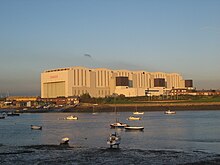
Many large companies and organisations are based in Cumbria, the county council itself employs around 17,000 individuals whilst the largest private employer in the Cumbria; Sellafield nuclear processing site has a workforce of 10,000. [4] Below is a list of some of the county's largest companies and employers (excluding services such as Cumbria Constabulary, Cumbria Fire and Rescue and the NHS in Cumbria), categorised by district:
- Allerdale
- Associated British Ports Holdings own and operate the port of Silloth. [5]
- Barrow-in-Furness
- Barrow's shipyard is one of the UK's largest, BAE Systems is the current owner of it and employs around 5,000. [6]
- The only Kimberly-Clark mill in the North of England is located in Barrow. [7]
- James Fisher & Sons is a large provider of marine engineering services and based in Barrow. [8]
- One of the largest single site furniture stores in the UK; Stollers is located in Barrow. [9]
- Carlisle
- Close to 1,000 people work in one of only two Pirelli tyre plants in the UK. [10]
- Carr's is a successful foodstuff and agricultural brand that was established in 1831 in Carlisle. [11]
- The Stobart Group which is one of the UK's largest haulage companies is headquartered in Carlisle. [12]
- Nestlé also operates a factory on the outskirts of Carlisle. [13]
- Cavaghan & Gray is a food manufacturing business based in Carlisle and a significant employer in the city. [14]
- Copeland
- As stated above, Sellafield is the largest private employer in the county, many West Cumbrians have links to the site. [15]
- Eden
- Center Parcs owns a large resort in Whinfell Forest near Penrith. [16]
- South Lakeland
- Pharmaceutical company GlaxoSmithKline operates a large factory in Ulverston. [17]
- International kitchenwear store Lakeland has its headquarters and flagship store in Windermere. [18]
- Farley Health Products a subsidiary of the Heinz Company runs a factory in Kendal. [19]
Tourism
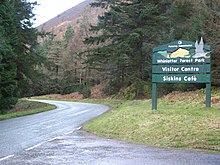
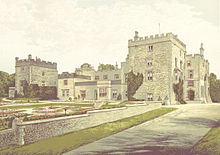
The largest and most widespread industry in Cumbria is tourism, the county receives some 15.3 million visitors every year (30 times the local population). [20] Over 36,000 Cumbrians are employed in the tourism industry which adds £1.1 billion to the county's economy on a yearly basis. The Lake District National Park is the single biggest draw; receiving in excess of 8.3 million visitors per year from across the UK, [21] Europe, North America and the Far East (particularly Japan). [21] Note that less than 50,000 people are permanently resident within the Lake District National Park - mostly in Ambleside, Bowness-on-Windermere, Coniston, Keswick, Grasmere and Windermere. [21] The tables below show the twenty most visited attractions in Cumbria in 2009 (please note that not all visitor attractions provided data to Cumbria Tourism who collated the list. Notable examples being Furness Abbey, the Lakes Aquarium and South Lakes Wild Animal Park, the latter of which would almost certainly rank within the top five). [22]
|
|
Economic output
This is a chart of trend of regional gross value added (GVA) of East Cumbria at current basic prices published (pp. 240–253) by Office for National Statistics with figures in millions of British Pounds Sterling.
| Year | Regional Gross Value Added [23] | Agriculture [24] | Industry [25] | Services [26] |
|---|---|---|---|---|
| 1995 | 2,679 | 148 | 902 | 1,629 |
| 2000 | 2,843 | 120 | 809 | 1,914 |
| 2003 | 3,388 | 129 | 924 | 2,335 |
This is a chart of trend of regional gross value added of West Cumbria at current basic prices published (pp. 240–253) by Office for National Statistics with figures in millions of British Pounds Sterling.
| Year | Regional Gross Value Added [23] | Agriculture [24] | Industry [25] | Services [26] |
|---|---|---|---|---|
| 1995 | 2,246 | 63 | 1,294 | 888 |
| 2000 | 2,415 | 53 | 1,212 | 1,150 |
| 2003 | 2,870 | 60 | 1,420 | 1,390 |
Education
Although Cumbria has a comprehensive system almost in toto, it has one state grammar school in Penrith. There are 42 state secondary schools and 10 independent schools. The more rural secondary schools tend to have sixth forms though in Barrow-in-Furness district no school except Chetwynde School (Independent) has a sixth form, and this is the same for three schools in Allerdale and South Lakeland, and one in the other districts.
Colleges of further education in Cumbria include Barrow-in-Furness Sixth Form College, Carlisle College, Cumbria Institute of the Arts, Furness College, Kendal College, Lakes College West Cumbria, West Cumbria Catholic Sixth Form Centre and Workington Sixth Form College.
The University of Cumbria is one of the UK's newest universities having been established in 2007, it is at present the only university in Cumbria and has campuses across the county.
Transport


The M6 is the only motorway than runs through Cumbria. Kendal and Penrith are amongst its primary destinations before it terminates just north of Carlisle. Major A roads within Cumbria include:
- A6 (Luton, Bedfordshire to Carlisle via Kendal and Penrith)
- A66 (Workington to Middlesbrough, North Yorkshire via Keswick, Penrith and Brough)
- A74, (Glasgow, Scotland to Carlisle)
- A590 (M6 Junction 36 to Barrow-in-Furness via Grange-over-Sands and Ulverston)
- A591 (Sizergh to Bothel via Kendal, Windermere, Ambleside, Grasmere and Kewsick)
- A592 (M6 Junction 40 to Staveley via Penrith, Windermere and Bowness-on-windermere)
- A595 (Carlisle to Dalton-in-Furness via Whitehaven and Workington)
- A596 (Carlisle to Workington)
Several bus companies ( Stagecoach North West being the largest, its depots are located in Barrow-in-Furness, Carlisle, Kendal and Workington) run services in Cumbria serving the main towns and villages in the county, with some services running to neighouring areas such as Lancaster. Stagecoach's flagship X35 route connects Barrow-in-Furness and Kendal in south Cumbria.
Carlisle Airport and Barrow/Walney Island Airport are the only two airports in the county. Both airports formerly served scheduled passenger flights and both proposing expansions and renovations to handle domestic and European flights in the near future. The nearest international airports to south Cumbria are Blackpool International Airport, Manchester Airport and Liverpool John Lennon Airport, whilst north Cumbria is in closer proximity to Newcastle Airport, Glasgow Prestwick Airport and Glasgow International Airport. Despite Barrow-in-Furness being one of the country's largest shipbuilding centres, the Port of Barrow is only minor and alongside every other port and harbour along the Cumbria coast has no ferry links in place.
The busiest railway stations in Cumbria are Carlisle station, Barrow-in-Furness station, Penrith station and Oxenholme Lake District station. The 399 mile long West Coast Main Line runs through the Cumbria countryside adjacent to the M6 motorway, the Cumbrian Coast Line which connects Barrow-in-Furness to Carlisle is a vital component in west Cumbrian transportation. Other railway lines solely in Cumbria include the Furness Line, the Settle-Carlisle Railway and the Windermere Branch Line.
Demography
Cumbria's largest settlement and only city, in the north of the county, is Carlisle, with the largest town, Barrow-in-Furness, being slightly smaller. The county's population is largely rural: it has the second lowest population density among English counties, and has only five towns with a population of over 20,000. Cumbria is also one of the country's least ethnically diverse counties, with 96% of the population categorised as indigenous White British (around 480,000 of the 500,000 Cumbrians). However, the larger towns have an ethnic makeup that is closer to the national average, and Cumbria's ethnic minority population is increasing twice as fast as England's average. The most followed religion in Cumbria by far is Christianity, followed by Buddhism and Islam.
| Population totals for Cumbria | |||||||
|---|---|---|---|---|---|---|---|
| Year | Population | Year | Population | Year | Population | ||
| 1801 | 173,017 | 1871 | 365,556 | 1941 | 456,833 | ||
| 1811 | 193,139 | 1881 | 410,856 | 1951 | 471,897 | ||
| 1821 | 225,555 | 1891 | 434,867 | 1961 | 473,706 | ||
| 1831 | 242,320 | 1901 | 437,364 | 1971 | 475,669 | ||
| 1841 | 255,603 | 1911 | 440,485 | 1981 | 471,693 | ||
| 1851 | 274,957 | 1921 | 441,483 | 1991 | 489,191 | ||
| 1861 | 320,257 | 1931 | 442,693 | 2001 | 487,607 | ||
| Pre-1974 statistics were gathered from local government areas that now comprise Cumbria Source: Great Britain Historical GIS. [27] | |||||||
Settlements
The table below has divided the settlements into their local authority district. Each district has a centre of administration; for some of these correlate with a district's largest town, while others are named after the geographical area.
| Ceremonial county | Administration borough/district | Centre of administration | Other towns, villages and settlements | |
|---|---|---|---|---|
| Cumbria | Allerdale | Workington |

|
Aspatria, Cockermouth, Harrington, Keswick, Maryport, Silloth, Wigton |
| Barrow-in-Furness | Barrow-in-Furness |
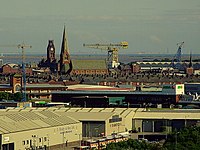
|
Askam and Ireleth, Dalton-in-Furness | |
| Carlisle | Carlisle |

|
Brampton, Dalston, Longtown | |
| Copeland | Whitehaven |

|
Cleator Moor, Egremont, Millom | |
| Eden | Penrith |

|
Alston, Appleby-in-Westmorland, Kirkby Stephen | |
| South Lakeland | Kendal |
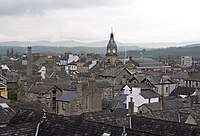
|
Ambleside, Bowness-on-Windermere, Coniston, Hawkshead, Heversham, Kirkby Lonsdale, Milnthorpe, Sedbergh, Ulverston, Windermere |
Town and city twinnings
Copeland is the only district in Cumbria not to contain a settlement with a twin town/sister city, whilst Barrow-in-Furness is the largest town in the county not to have such an arrangement.
| Settlement | District | Twinned settlement |
|---|---|---|
| Carlisle | Carlisle |
|
| Cockermouth | Allerdale |
|
| Dalton-in-Furness | Barrow-in-Furness |
|
| Kendal | South Lakeland |
|
| Penrith | Eden |
|
| Sedbergh | South Lakeland |
|
| Ulverston | South Lakeland |
|
| Workington | Allerdale |
|
Symbols and county emblems
The arms of Cumbria County Council were granted by the College of Arms on 10 October 1974. The arms represent the areas from which the new county council's area was put together; the shield's green border has Parnassus flowers representing Cumberland interspersed with roses; red for Lancashire (the Furness district) on white for Yorkshire (Sedbergh is from the West Riding). The crest is a ram's head crest, found in the arms both of Westmorland County Council and Barrow County Borough, with Cumberland's Parnassus flowers again. The supporters are the legendary Dacre Bull (Cumberland) and a red dragon ( Appleby in Westmorland), with a hint of the Welsh Kingdom of Rheged. They stand on a base compartment representing Hadrian's Wall (in Cumberland), crossed with two red bars (from the Westmorland arms). [28]
The county council motto: "Ad Montes Oculos Levavi" is Latin, from Psalm 121; ("I shall lift up mine eyes unto the hills"). [28]
There are two unofficial flags for Cumberland and Westmorland. These are the white cross on a blue background for Cumberland and the red cross on a yellow background for Westmorland. There are also two unofficial Cumbrian flags:
1. Consists of a green upper half with three white roses and a lower half consisting of three white and three blue horizontal stripes.
2. Consists of blue upper third, green lower third, and white middle third with the county heraldic crest in the centre.
Sport
Football
Carlisle United are the only professional football team in Cumbria and currently play in League One (3rd Tier in the English football pyramid). They attract support from across Cumbria and beyond, with many Cumbrian "ex-pats" travelling to see their games, both home and away. Whilst home attendances are usually 7,000 to 10,000, the away support is often 1,000 to 2,000. This is one of the highest proportions of away-home support in England.
Barrow and Workington Reds are well supported non-league teams, having both been relegated from the Football League in the 1970s, with Barrow being one of the best supported non-league football teams in the UK. Recently Workington Reds have made a rapid rise up the non league ladder and in 2007/08 competed with Barrow in the Conference North (Tier 6). Barrow were then promoted to the Blue Square Premier (Tier 5) in 2007/08.
Rugby league
Rugby league is a very popular sport in South and West Cumbria. Barrow Raiders, Whitehaven RLFC and Workington Town and all compete in the National Leagues. Carlisle RLFC played in the national competitions between 1981 and 1997, Carlisle today has Carlisle Centurions in the Rugby League Conference. There are amateur BARLA teams playing in the National Conference, notably Wath Brow Hornets and Millom as well as a Cumberland League and Barrow & District League.
Rugby union
Rugby union is very popular in the east of the county with teams such as Carlisle RUFC, Kendal RUFC, Kirkby Lonsdale RUFC, Keswick RUFC, Upper Eden RUFC and Penrith RUFC (who have recently been promoted to the National Leagues) competing in many local and national competitions.
Cricket
Cumberland County Cricket Club is one of the cricket clubs that constitute the Minor Counties in the English domestic cricket structure. The club, based in Carlisle, competes in the Minor Counties Championship and the MCCA Knockout Trophy. The club also play some home matches in Workington, as well as other locations.
Cumbrian club cricket teams play in the North Lancashire and Cumbria League.
Uppies and Downies
Workington is home to the ball game known as Uppies and Downies, [29] a traditional version of football, with its origins in Medieval football or an even earlier form. [30] Players from outside Workington do take part, especially fellow West Cumbrians from Whitehaven and Maryport. [31]
Wrestling
Cumberland and Westmorland wrestling is an ancient and well-practised tradition in the county with a strong resemblance to Scottish Backhold.
In the 21st century Cumberland and Westmorland wrestling along with other aspects of Lakeland culture are practised at the Grasmere Sports and Show, an annual meeting held every year since 1852 on the August Bank Holiday.
The origin of this form of wrestling is a matter of debate, with some describing it as having evolved from Norse wrestling brought over by Viking invaders, [32] while other historians associate it with the Cornish and Gouren styles [33] indicating that it may have developed out of a longer-standing Celtic tradition. [34]
Places of interest
| Key | |
|
|
Abbey/Priory/Cathedral |
|
|
Accessible open space |
|
|
Amusement/Theme Park |
|
|
Castle |
|
|
Country Park |
|
|
English Heritage |
| Forestry Commission | |
|
|
Heritage railway |
|
|
Historic House |
|
|
Places of Worship |
|
|
Museum (free/not free) |
|
|
National Trust |
|
|
Theatre |
|
|
Zoo |
See also:
List of castles in Cumbria
See also:
List of historic houses in Cumbria
See also:
List of Museums in Cumbria



Notable people
See also:
List of people from Carlisle
See also:
List of people from Barrow-in-Furness
See also:
List of people from Kendal
See also
- Anglo-Scottish border
- Cumbrian dialect
- Etymology of Cumbrian Place Names
- List of Cumbria-related topics
- Cumbria shootings
References
- ^ Online Etymological Dictionary Cymric
-
^ Davies, John (1990/2007). A History of Wales. London: Penguin Books. pp. 68–69.
{{ cite book}}: Check date values in:|date=( help) - ^ "County council votes to pursue a single council for Cumbria". Retrieved 2007-02-24.
- ^ "Cumbrian employers supporting staff after multiple shooting". Personneltoday. Retrieved 15 July 2010.
- ^ "Port of Silloth". Associated British Ports Holdings. Retrieved 16 July 2010.
- ^ "BAE Systems Barrow". BAE Systems. Retrieved 15 July 2010.
- ^ "Kimberly-Clark Barrow". Kimberly-Clark. Retrieved 15 July 2010.
- ^ "James Fisher & Sons Barrow". James Fisher & Sons. Retrieved 15 July 2010.
- ^ "Stollers Barrow". Stollers. Retrieved 16 July 2010.
- ^ "Pirelli Carlisle". Pirelli. Retrieved 15 July 2010.
- ^ "Carr's Carlisle". Carr's. Retrieved 15 July 2010.
- ^ "Stobart Carlisle". Stobart. Retrieved 15 July 2010.
- ^ "Nestlé Carlisle". ukbusinesspark. Retrieved 15 July 2010.
- ^ "Cavaghan & Gray Carlisle". Carlisle City Council. Retrieved 15 July 2010.
- ^ "Sellafield". Sellafield. Retrieved 16 July 2010.
- ^ "Center Parcs". Center Parcs. Retrieved 16 July 2010.
- ^ "GlaxoSmithKline Ulverston". GlaxoSmithKline. Retrieved 16 July 2010.
- ^ "Lakeland Windermere". Lakeland. Retrieved 16 July 2010.
- ^ "Heinz Kendal". Applegate. Retrieved 16 July 2010.
- ^ "Funding for Cumbria Tourism is slashed by half". BBC. Retrieved 3 August 2010.
- ^ a b c "Lake District National Park". Lake District National Park. Retrieved 16 July 2010.
- ^ "Lake District National Park". Visit Cumbria. Retrieved 16 July 2010.
- ^ a b Components may not sum to totals due to rounding
- ^ a b includes hunting and forestry
- ^ a b includes energy and construction
- ^ a b includes financial intermediation services indirectly measured
- ^ A Vision of Britain through time, Cumbria Modern (post 1974) County: Total Population, retrieved 2010-01-10
- ^ a b Cumbria County Council (Civic Heraldry) accessed 24 January 2010
- ^ "Uppies and Downies website". Retrieved 2009-06-25.
- ^ Origins of Mass ball Games. Retrieved 2009-06-25.
- ^ "Times and Star". Retrieved 2009-06-25.
- ^ "Kronos; A Chronology of the Martial Arts and Combative Sports". Retrieved 2007-02-24.
- ^ "Amateur Wrestling". Retrieved 2007-02-24.
- ^ "Kronos; A Chronology of the Martial Arts and Combative Sports". Retrieved 2007-02-24.
External links
- The Cumbria online forum.
- Official Tourist Board Website
- Cumbria Tourist and Historical Website
- The Cumbria Site - Local information
- BBC Cumbria Digital Lives Project
- Carlisle Diocese (Church of England)
- The Kirkby Lonsdale Show
- The Museum of Lakeland Life Website
- thedialectdictionary.com - Compilation of dialects including Cumbrian
- Go Lakes
- Neezes/draft at Curlie
